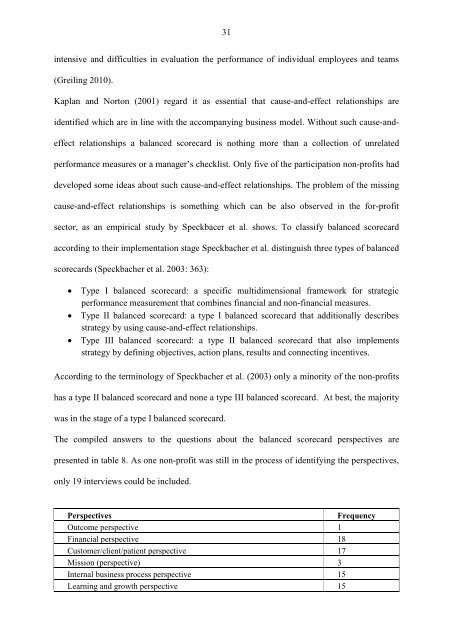Strategic responses to Performance Measurement in Nonprofit ...
Strategic responses to Performance Measurement in Nonprofit ...
Strategic responses to Performance Measurement in Nonprofit ...
You also want an ePaper? Increase the reach of your titles
YUMPU automatically turns print PDFs into web optimized ePapers that Google loves.
31<br />
<strong>in</strong>tensive and difficulties <strong>in</strong> evaluation the performance of <strong>in</strong>dividual employees and teams<br />
(Greil<strong>in</strong>g 2010).<br />
Kaplan and Nor<strong>to</strong>n (2001) regard it as essential that cause-and-effect relationships are<br />
identified which are <strong>in</strong> l<strong>in</strong>e with the accompany<strong>in</strong>g bus<strong>in</strong>ess model. Without such cause-and-<br />
effect relationships a balanced scorecard is noth<strong>in</strong>g more than a collection of unrelated<br />
performance measures or a manager‟s checklist. Only five of the participation non-profits had<br />
developed some ideas about such cause-and-effect relationships. The problem of the miss<strong>in</strong>g<br />
cause-and-effect relationships is someth<strong>in</strong>g which can be also observed <strong>in</strong> the for-profit<br />
sec<strong>to</strong>r, as an empirical study by Speckbacer et al. shows. To classify balanced scorecard<br />
accord<strong>in</strong>g <strong>to</strong> their implementation stage Speckbacher et al. dist<strong>in</strong>guish three types of balanced<br />
scorecards (Speckbacher et al. 2003: 363):<br />
Type I balanced scorecard: a specific multidimensional framework for strategic<br />
performance measurement that comb<strong>in</strong>es f<strong>in</strong>ancial and non-f<strong>in</strong>ancial measures.<br />
Type II balanced scorecard: a type I balanced scorecard that additionally describes<br />
strategy by us<strong>in</strong>g cause-and-effect relationships.<br />
Type III balanced scorecard: a type II balanced scorecard that also implements<br />
strategy by def<strong>in</strong><strong>in</strong>g objectives, action plans, results and connect<strong>in</strong>g <strong>in</strong>centives.<br />
Accord<strong>in</strong>g <strong>to</strong> the term<strong>in</strong>ology of Speckbacher et al. (2003) only a m<strong>in</strong>ority of the non-profits<br />
has a type II balanced scorecard and none a type III balanced scorecard. At best, the majority<br />
was <strong>in</strong> the stage of a type I balanced scorecard.<br />
The compiled answers <strong>to</strong> the questions about the balanced scorecard perspectives are<br />
presented <strong>in</strong> table 8. As one non-profit was still <strong>in</strong> the process of identify<strong>in</strong>g the perspectives,<br />
only 19 <strong>in</strong>terviews could be <strong>in</strong>cluded.<br />
Perspectives Frequency<br />
Outcome perspective 1<br />
F<strong>in</strong>ancial perspective 18<br />
Cus<strong>to</strong>mer/client/patient perspective 17<br />
Mission (perspective) 3<br />
Internal bus<strong>in</strong>ess process perspective 15<br />
Learn<strong>in</strong>g and growth perspective 15
















